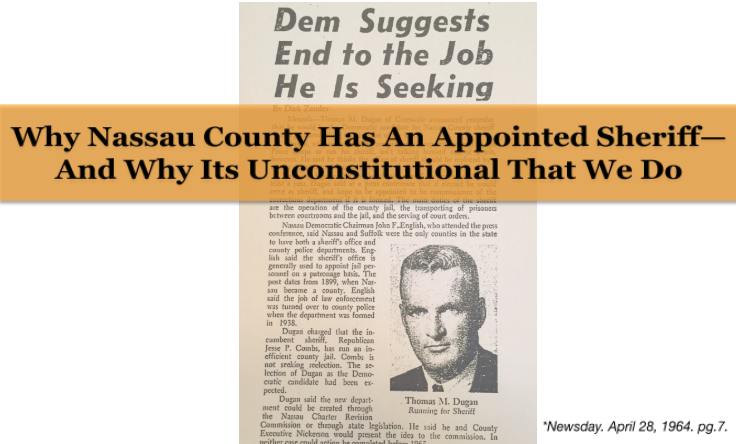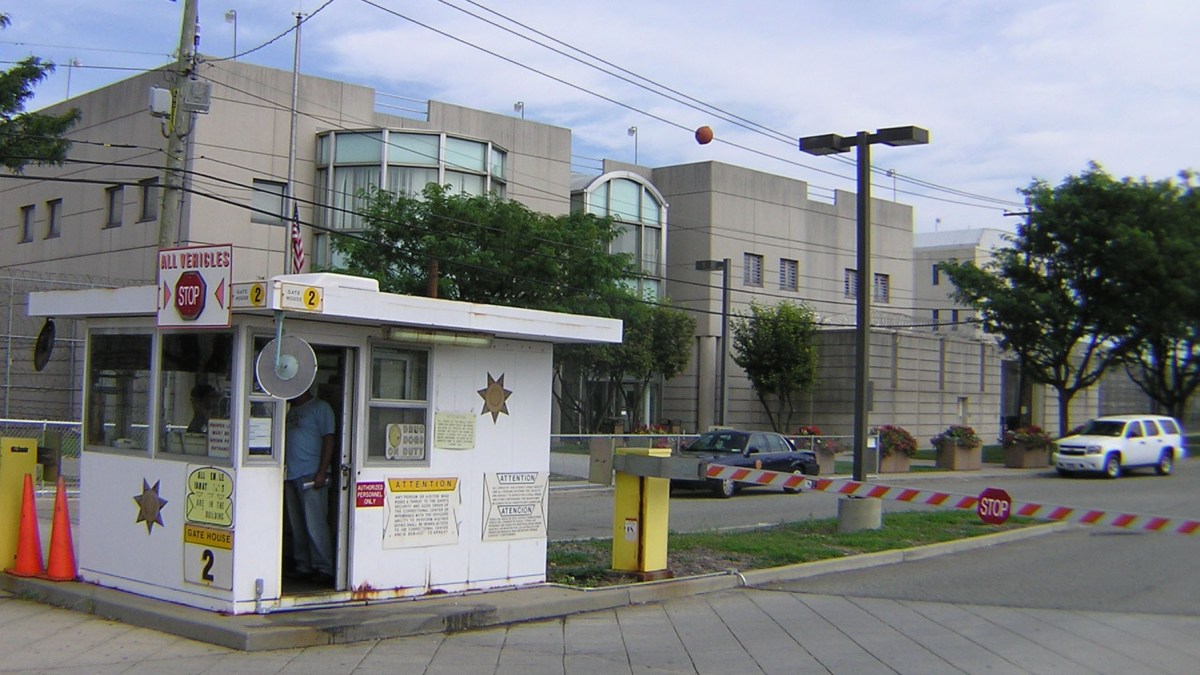The New York State Constitution mandates that the position of sheriff in 57 counties statewide — except for the five that make up New York City — be an elective office.
So why is the Nassau County Sheriff an appointed position?
“The sheriff … of each county shall be chosen by the electors,” states Article XIII, Section 13 of the Empire State’s constitution.
A brief history illustrates how those in power more than 50 years ago came to put Nassau in conflict with the supreme law of the state.
On April 27, 1964, then-Nassau County Sheriff candidate Thomas M. Dugan held a press conference in Mineola calling for the position to be transformed from an elective office to that of an appointed position.
Although Dugan, a Democrat from Greenvale, was essentially campaigning on a pledge to end the $19,775-a-year position he would assume if he won the November election, his rationale was a simple and familiar one. The sheriff’s office, which manages the safety and security of inmates at county jails, transports prisoners, conducts evictions, and executes warrants, was “traditionally filled by party hacks” of the local Republican Party, who then gave jobs out to “lesser and unqualified party hacks.”
Dugan alleged that “personnel at the county jail were forced to pay one percent of their annual salary as a kick back to the Republican Party,” according to Newsday reporting during the campaign. Dugan cited Sheriff Jesse Combs, a Republican in office at the time, of having “coerced 150 GOP county workers to attend a campaign meeting and to make contributions to the party.” Dugan advocated that the Nassau County Sheriff’s position be removed from the political realm to that of an appointed position and that nearly all other jail positions personnel be filled through civil service.
He argued this would curb corruption and improve efficiency. In spite of running in a county where Republicans had 130,000 more enrolled voters than Democrats, Dugan won by 53,386 votes after a hard-fought campaign.
Just 11 days after being sworn into office, Dugan died suddenly of a heart attack. He was 37 years old.
Two months later, three Nassau Democrats introduced a bill in the state legislature proposing that the position of Nassau County Sheriff be appointed rather than elected. The measure passed both chambers.
“Tom Dugan’s Bill,” as it had come to be known, hit a roadblock when it landed on the desk of then-Gov. Nelson Rockefeller. In his veto message to the legislature in rejecting the measure, the governor stated the legislation should be handled at the county level, not the state. Rockefeller was referencing Article IX of the New York Constitution, which allows for each local government to initiate a referendum regarding removing power from elective officials. 
“[A]ny … local law which … transfers to another county officer or agency any power of an elective county officer … shall be subject to a permissive referendum,” it states.
Local lawmakers in Nassau quickly took up the issue. Five days after the defeat in Albany, the Nassau Board of Supervisors — the predecessor to the Nassau County Legislature — passed a resolution in August of 1965 agreeing to put the matter before voters that November.
The local proposal was known as Proposition No. 1. It detailed that the Nassau County executive would appoint the sheriff with approval by a majority of the board. To obtain bipartisan support, it was stipulated that if Prop 1 passed, it wouldn’t take effect until 1968.
Newsday weighed in on the measure just days before voters went to the polls.
“We believe this is a worthwhile effort to streamline and update an important division of county government and we urge a ‘yes’ vote on this proposition,” the newspaper editorialized.
Had Rockefeller or Albany lawmakers or the Nassau Board of Supervisors read the state constitution beyond Article IX, which supported their objective, they would have noticed Article XIII, which didn’t. This section forbids both the legislature’s majority will and referendum action regarding a very specific officeholder: The county sheriff.
Again, article XIII reads “the sheriff … of each county shall be chosen by the electors.” If our state constitution provided a flexible option for the position to no longer be elective, as was the office in 1965, the constitution would read “the sheriff…of each county may be chosen by the electors.” (emphasis added)
Proposition 1 was approved by a landslide 294,721 to 79,685 vote in November of 1965. On Jan. 1, 1968, Joseph F. Maher was sworn in as the first appointed — and unconstitutional — sheriff in Nassau County history.
Over the past half century, Thomas Dugan’s vision to end the cycle of patronage and corruption has achieved mixed results. While civil service employees have served the correctional system well, the appointment of Nassau County Sheriff has created as much cronyism as when the position was elective. We need only look to recent headlines to see that the accountability and transparency residents deserve remains seriously wanting.
In addition, an important, broader principle is involved. The New York State Constitution, which is a cornerstone of governmental structure, was and continues to be willfully violated. That must be corrected.
Local elected officials cannot continue to intentionally ignore the obvious meaning of words they take an oath to even if they think they can. One simple and easy solution would be to follow the established legal mandate and allow the voters to decide who will be our next sheriff at the next election.
Only then will leaders in Nassau County fulfill their obligation to the electorate — and to the state constitution.
James Coll, a registered Republican, is a retired NYPD detective and the founder of ChangeNYS.org.
Carl Achille, a registered Democrat, is a former candidate for Congress in New York’s 5th District and a criminal justice professional.



































